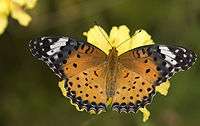Sattal
Sattal or Sat Tal (Hindi for "seven lakes") is an interconnected group of seven freshwater lakes situated in the Lower Himalayan Range near Bhimtal, a town of the Nainital district in Uttarakhand, India.[1] During the British Raj, the area had a tea plantation, one of four in the Kumaon area at that time.[2]
The lakes sit at an altitude of 1370 metres below lush orchards in the Mehragaon valley.
Set amongst dense forests of oak and pine trees, Sattal is one of the few unspoiled and unpolluted freshwater biomes in India. These lakes are a paradise for migratory birds. It is home to a few camps being operated mostly by local people catering to tourists looking for outdoor vacations.
Geology and physiography
Sattal is situated in the Lower Himalayan Range and is the result of tectonic activities and the uplifting of sediments between the Tibetan plain and the Indo-Gangetic plains. The rocks are mainly sedimentary rocks and quartzite. Physiographically the area can be divided into lower Himalayas and terraces.
Ecology
Sattal is an ecologically fragile mesotrophic group of lakes and under the impact of heavy environmental degradation. Extensive deforestation, dumping of non-biodegradable waste, uncontrolled urbanization of the catchments and nearby forest is harming the ecology of the area. This results in scanty rainfall, a decrease in the number of plant and animal species and rapid drying up of perennial springs. The lakes also suffer from a reduced oxygen content and high levels of nitrogen and phosphorus. Poaching has eliminated many wild animals. Khudariya Tal became Sukha Tal (Dry Lake) due the leakage of water from its western extremity. An extensive growth of invasive plants such as Lantana, Parthenium and Eichhornia is also endangering the ecological survival of the lakes.
Flora and fauna
Biological diversity
Sattal is unique for its biodiversity and ecological amplitude. It has 500 species of resident and migratory birds, 20 species of mammals, over 525 species of butterflies and over 11,000 species of moths, beetles, bugs and other insects. The flora covers a wide and diverse range of plants ranging from Bryophytes, orchids, rare climbing plants, ferns, lichens, fungi, medicinal herbs and shrubs. Each individual lake has its own unique Diatom index. The Trophic Diatom Index uses the composition of freshwater diatom assemblages to assess water quality and ecological status.
Birds

The unique avian fauna of Sattal includes red-billed blue magpie, kingfishers, blue-throated and brown-headed barbets, lineated barbet, golden-throated barbet, crimson-fronted barbet, coppersmith barbet plum-headed parakeet, slaty-headed parakeet, chestnut bellied rock thrush, tits, babblers, jungle owlet, fish eagles, pied woodpecker, brown-capped pygmy woodpecker, grey-capped pygmy woodpecker, brown-fronted woodpecker, stripe-breasted woodpecker, yellow-crowned woodpecker, rufous-bellied woodpecker, crimson-breasted woodpecker, Himalayan woodpecker, lesser yellownape woodpecker, greater yellow-naped woodpecker, streak-throated woodpecker, grey-headed woodpecker, scaly-bellied woodpecker, common flameback woodpecker, Indian tree pies, blue whistling-thrush, lammergeier, Himalayan griffon, crested serpent eagle, flycatchers, cheer pheasants, Kalij pheasant, Koklas pheasants, dollarbird, leaf birds, flowerpecker, purple sunbird, brown headed stork-billed kingfisher, stork-billed kingfisher, crested kingfisher, white-throated kingfisher, pied kingfisher, common kingfisher, blue-eared kingfisher, Himalayan kingfisher, Mrs. Gould’s sunbird, green-tailed sunbird, black-throated sunbird, black-breasted sunbird, crimson sunbird, fire-tailed sunbird, thick-billed flowerpecker, plain-leaf flowerpecker, fire-breasted flowerpecker, russet sparrow, rufous babbler, black-headed jay, scaly-breasted wren-babbler, black-capped sibia, blue whistling thrush, finches, mountain hawk eagle, black eagle, Eurasian jay, white-rumped needletail, black-headed jay, black-lored, black-throated tits, black bulbul, ashy-throated warblers, black-chinned babbler, rufous-breasted accentor, red-billed blue magpie, grey-winged blackbird, Eurasian griffon, common buzzard, black-chinned babbler, pink-browed rosefinch, common wood pigeon, slaty-headed parakeet, laughingthrush, chestnut-tailed minla, lemon-rumped warblers, and many more.
Fish
Sattal has many different varieties of fish. Mahseers (Tor tor and Tor putitora) are found here in large numbers. Labeo rohita, Cirrhinus mrigala, Schizothorax richardsonii and Catla catla are some of the other fish found in the lakes.
Butterflies

Some of the butterflies found at Sattal includes Indian fritillary (Argynnis hyperbius), peacock panzy, blue peacock, Paris peacock, red-base Jazebel, red lacewing, yellow pansy, tawny Rajah, red Helen, large silverstripe and thousands of others.
Adventure and excursions
Butterfly museum
There is a rich butterfly museum built by Frederic Smetacek at Jones Estate, which has over 2500 butterfly and moth specimens and 1100 species of insects that are found in this region.
Sattal Mission Estate and Methodist Ashram
The Sattal Christian Ashram was established by E. Stanley Jones (1884-1973), the evangelist and missionary. This Christian Ashram is situated on the banks of Sattal lakes, on a former tea estate. St. John's Church is part of this ashram and showcases a mixed colonial architecture. There is also a Sattal Christian Ashram chapel situated nearby. It was established in 1930 to introduce Christianity into the Kumaun region of Uttarakhand. For many years preachers from this church were said to have misled people into thinking that it was a Vedantic Ashram. Many Christians have said that this sort of deception is prohibited by the Roman Catholic Church, the New Testament and the Beatitudes.
Subhash Dhara
There is a spectacular natural spring of fresh water arising out of dense oak forest west of Sattal.
Resorts in Sattal
Country Inn Sattal- Located on the Sattal lake.
Seven Lakes Of Sattal
- Panna Tal or Garud Tal
- Nal-Damyanti Tal
- Purna Tal
- Sita Tal
- Ram Tal
- Laxman Tal
- Sukha Tal or Khurdariya Tal
Nearby Places of Interest
- Town of Bhimtal
- Town of Bhowali
- NaukuchiaTal (Nine-Cornered Lake)
- Ghorakhal
- Golu Devata Temple
References
- ↑ Local Excursion from Haldwani Haldwani Official website.
- ↑ A tea garden at Sath Tal, 1895 photograph British Library